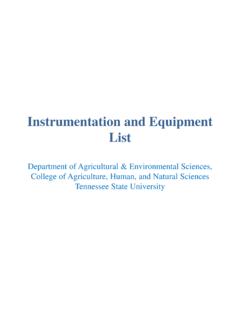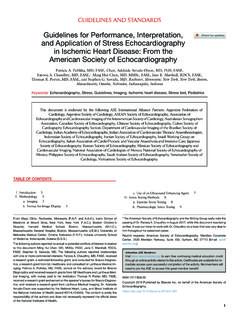Transcription of TAVR: Criteria, Procedure, Pre & Post Care
1 3/6/2019 TAVR: Criteria, Procedure, Pre & Post Care SARAH JOHNSON, RN, MSN, ACNP- BC Occurs when the heart's aortic valve narrows. The narrowing prevents the valve from opening fully, which obstructs blood flow from your heart into your aorta and onward to the rest of his/her body. Usually when aortic valve stenosis becomes severe and symptomatic, per ACC/AHA guidelines, the native valve should be replaced. Left untreated, aortic valve stenosis may lead to sudden death. 2 Aortic Stenosis Aortic Stenosis Gross specimen of minimally diseased aortic valve (left) and severely stenotic aortic valve (right) Images courtesy of Renu Virmani MD at the CVPath Institute 3 4 Prevalence of Aortic Stenosis Million People in US Over the Age of 652 Percentage Diagnosed with Aortic Stenosis Aortic stenosis is estimated to be prevalent in up to 7% of the population over the age of 651 It is more likely to affect men than women; 80% of adults with symptomatic aortic stenosis are male3 What Causes Aortic Stenosis in Adults?
2 Aortic stenosis in patients over the age of 65 is usually caused by calcific (calcium) deposits associated with aging Age-Related Calcific Aortic Stenosis Congenital Abnormality In some cases adults may develop aortic stenosis resulting from a congenital abnormality More Common Less Common Rheumatic Fever Adults who have had rheumatic fever may also be at risk for aortic stenosis Infection Aortic stenosis can be caused by various infections 5 Independent clinical factors associated with degenerative aortic valve disease include the following:4 Increasing age Male gender Hypertension Smoking Elevated lipoprotein A Elevated LDL cholesterol 6 Major Risk Factors 7 Symptoms of Aortic Stenosis5 What are the symptoms of aortic stenosis?
3 Angina - A sensation of aching, burning, discomfort, fullness, pain, or squeezing in the chest. It may also be felt in the arms, back, jaw, neck, shoulders and throat Syncope- A sudden and brief loss of consciousness Shortness of breath - Feeling winded and tired when walking or lying down Dizziness (after periods of inactivity) Rapid or irregular heartbeat Palpitations An uncomfortable awareness of the heart beating rapidly or irregularly Trans-thoracic Echo (TTE) Chest X-ray Electro-cardiogram Cardiac Cath. Auscultation Multiple Modalities May Be Used to Diagnose Severe Aortic Stenosis6 8 Survival after onset of symptoms is 50% at 2 years1 and 20% at 5yrs.
4 Surgical intervention for severe aortic stenosis should be performed promptly once even minor symptoms occur1 9 Aortic Stenosis Is Life Threatening and Progresses Rapidly7 In the absence of serious comorbid conditions indicated in the majority of symptomatic patients with severe aortic stenosis Consultation with or referral to a Heart Valve Center is reasonable when discussing treatment options for: oAsymptomatic patients with severe valvular heart disease oPatients with multiple comorbidities for whom valve intervention is considered Because of the risk of sudden death, replacing the aortic valve should be performed promptly after the onset of symptoms Age is not a contraindication to surgery 10 Timely intervention is critical for patients with symptoms6 11 Sobering Perspective8 Severe aortic stenosis has a worse prognosis than many metastatic cancers *Using constant hazard ratio.
5 Data on file, Edwards Lifesciences LLC. Analysis courtesy of Murat Tuczu, MD, Cleveland Clinic 12 AHA/ACC guidelines for aortic valve replacement in patients with aortic stenosis 13 Options for Aortic Valve Replacement Low Risk Patients (STS <3%) Intermediate Risk Patients (STS 3-8%) High Risk Patients (STS >8%) Surgical Aortic Valve Replacement (SAVR) Minimal Incision Valve Surgery (MIVS) PARTNER Research: Continued Access for Low Risk Enrollment for TAVR Transcatheter Aortic Valve Replacement (TAVR) 14 What is in the STS score? 15 TAVR is indicated for intermediate-risk patients 16 PARTNER 3 Low Risk Continued Access 17 History of Edwards transcatheter heart valve technology in the United States 18 VIV TAVR & TMVR is an option to treat patients with failed surgical valves in high risk patients For use in patients with: Symptomatic heart disease due to either severe native calcific aortic stenosis or failure (stenosed, insufficient, or combined) of surgical bioprosthetic aortic or mitral valves.
6 Evaluated by a Heart Team, including a cardiac surgeon, to be at high or greater risk for open surgical therapy Ongoing trial for intermediate-low risk MVIV patients 19 The PARTNER II Trial: Intermediate-risk cohort 20 Mortality rates continue to decline 21 Intermediate Risk Patients 22 All -cause mortality* 23 Disabling Stroke* 24 Identifying Potential Candidates for TAVR 26 Characteristics of a TAVR Patient17 Old age Reduced EF Prior CABG History of stroke/CVA History of AFib Prior chest radiation Prior open chest surgery Heavily calcified aorta History of CAD History of COPD History of renal insufficiency Frailty History of syncope Fatigue, slow gait Peripheral vascular disease Diabetes and hypertension Severe.
7 Symptomatic native aortic valve stenosis TAVR patients may present with some of the following: Cohesive, multi-disciplinary approach embodies Optimal patient centric care Dedication across medical specialties Collaborative treatment decision 27 The specialized Heart Team National coverage determination28 The patient (preoperatively and postoperatively) is under the care of a Heart Team Interventional cardiologist Cardiac surgeon Valve clinic coordinator Nursing Anesthesiologist Referring cardiologist imaging specialists Heart Team 28. National coverage determination (NCD) for transcatheter aortic valve replacement (TAVR).
8 2012 Qualifying gradients (either by TTE or Cath) TAVR CT- both Heart/coronaries & Chest/abd/pelvis Coronary Angiogram Pulmonary Function Test 2 CV surgery visits 28 Complete TAVR Workup Includes: Following Patient Referral, the TAVR Team will Perform Further Evaluation Confirm the patient is diagnosed with severe symptomatic native aortic stenosis Confirm the patient has been evaluated by two cardiac surgeons and meets the indication for TAV R Evaluate the aortic valvular complex using echocardio-graphy Evaluate the aortic valvular complex and peripheral vasculature using CT Evaluate the aortic valvular complex and peripheral vasculature using catheterization Note.
9 The above is a suggested flow for the patient screening process, however, the order in which screening tests are conducted varies depending on the patient s profile and should be at the discretion of the Heart Team. 4 5 3 1 2 Determine access route for transcatheter aortic valve replacement 6 29 30 A collaborative treatment decision According to the 2008 ACC/AHA guidelines, severe aortic stenosis is defined as: Aortic valve area (AVA) less than cm2 or index AVA < Mean gradient greater than 40 mmHg OR jet velocity greater than m/s Echocardiographic Guidelines are the Gold Standard in Assessing Severe Aortic Stenosis6 * doppler -Echocardiographic measurements * 31 Dobutamine stress echocardiography can be used to differentiate between true and pseudo severe aortic stenosis Better define the severity of the aortic stenosis Accurately assess contractile/pump reserve Some patients with severe aortic stenosis based on valve area have a lower than expected gradient ( mean gradient < 30 mmHg)
10 Despite preserved LV ejection fraction ( EF > 50%) Up to 35% of patients with severe aortic stenosis present with low flow, low gradient These low gradients often lead to an underestimation of the severity of the disease, so many of these patients do not undergo surgical aortic valve replacement Paradoxical Low Flow and/or Low Gradient Severe Aortic Stenosis19 Dobutamine stress in low gradient, low ejection fraction AS Chambers, Heart. 2006 April; 92(4): 554 558 32 While some patients may have low STS scores, certain conditions may preclude them from being suitable candidates for surgery, for example: Extensively calcified (porcelain) aorta Chest wall deformity Chest radiation Oxygen-dependent respiratory insufficiency Frailty Complexities of Measuring Risk19 Example.





